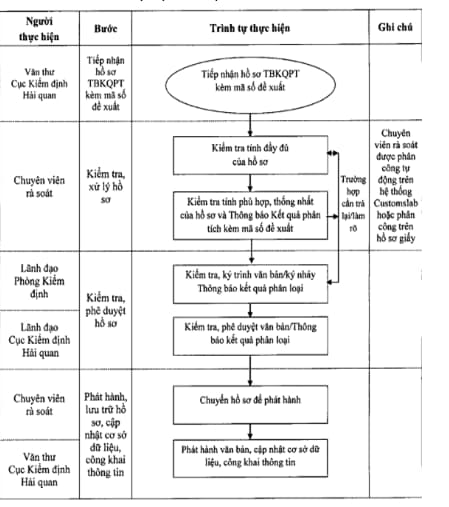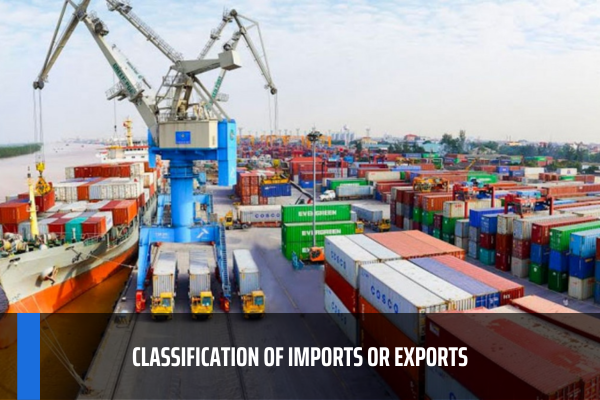What is the diagram of sampling process, preparing analysis request documents at the requesting unit and receiving, checking, and processing documents requesting issuance of notices at the Customs Inspection Department in Vietnam?
- What is the diagram of sampling process, preparing analysis request documents at the requesting unit and receiving, checking, and processing documents requesting issuance of notices at the Customs Inspection Department in Vietnam?
- What is the application for analysis for classification of imports or exports in Vietnam?
- What is the sampling method for classification of imports or exports in Vietnam?
What is the diagram of sampling process, preparing analysis request documents at the requesting unit and receiving, checking, and processing documents requesting issuance of notices at the Customs Inspection Department in Vietnam?
In Appendix III issued with Decision 2166/QD-TCHQ in 2021, the diagram of sampling process, preparing analysis request documents at the requesting unit, and receiving, checking, and processing documents is clearly stated. Request analysis and issue notification of analysis results at the Customs Inspection Department in Vietnam as follows:

At the same time, Appendix III issued with Decision 2166/QD-TCHQ in 2021 clearly states the process diagram for receiving, checking, and processing dossiers announcing analysis results with proposed and issued codes. Notice of classification results at the Customs Inspection Department as follows:


What is the diagram of sampling process, preparing analysis request documents at the requesting unit and receiving, checking, and processing documents requesting issuance of notices at the Customs Inspection Department in Vietnam? (Image from the Internet)
What is the application for analysis for classification of imports or exports in Vietnam?
Pursuant to the provisions in Article 4 of the Process attached to Decision 2166/QD-TCHQ in 2021, it is clearly stated as follows:
Application for analysis for classification
1. An application for analysis for classification includes:
a) Documents bearing a stamp across the margins of their consecutive pages, including:
a.1) A request form for analysis of imports/ exports cum sampling record (hereinafter referred to as “analysis request form”) which is made using Form No. 05/PYCPT/2021 enclosed with the Circular No. 17/2021/TT-BTC. An analysis request form shall be submitted for each type of goods.
Grounds for suspicion that the code of goods has been inaccurately declared, suspected code, criteria to be analyzed, as specified in HS explanatory notes, supplementary explanatory notes to AHTN, Vietnam’s nomenclature of exports and imports, and import and export tariff schedules, and number and date of the directive of the online service watch officer or General Department of Vietnam Customs (if any) shall be specified in Section 13 of the analysis request form.
If the Customs Branch of Goods Verification cooperates with the requesting unit to take samples, only the name of the customs official of the requesting unit shall be specified at the lines "customs official 1" and "customs official 2” in Section 7 of the analysis request form.
a.2) The form recording numbers and dates of documents included in the customs dossier concerning the sample of goods, which is made using Form No. 01/PGTL/2021 in Annex IV enclosed herewith;
a.3) Technical documents (copies). In case of absence of technical documents, the requesting unit shall provide the reasons for such absence of technical documents in Section 12 of the analysis request form.
If technical documents are provided after the receipt of application, the requesting unit shall send an official dispatch, accompanied by such technical documents, to the Customs Branch of Goods Verification.
a.4) The screenshot displaying the completion of input of information on the analysis request form into the MHS system;
a.5) The screenshot displaying the completed searching on the database without reference information obtained. Searching information must include at least the followings: the commercial name specified in the documents included in the customs dossier; the declared name of the good (description of good according to Vietnam’s nomenclature of exports and imports) and declared code of good; the declared name of good (description of good according to Vietnam’s nomenclature of exports and imports) and suspected code.
a.6) The inspection result record (if any) made by the chemical testing officer according to Form No. 06/PGKQKT/GSQL in Annex II enclosed with Circular No. 39/2018/TT-BTC;
a.7) Copies of other documents included in the customs dossier (if available), including: Commercial contract (or commercial invoice), Certificate of Origin (C/O), Certificate of Analysis (C/A), Certificate of Quality (C/Q), and other relevant documents.
b) Samples of goods.
c) If multiple types of goods are specified on the same customs declaration, only an application for analysis for classification which includes the number of analysis request forms corresponding to types of goods shall be submitted.
2. The requesting unit must submit the application for analysis within 02 working days from the sampling date so as to ensure the degradation of samples. The requesting unit shall send the application for analysis for classification to the Customs Branch of Goods Verification by post or express mail or directly.
Accordingly, the application for analysis for classification of imports or exports includes the documents specified above.
What is the sampling method for classification of imports or exports in Vietnam?
Pursuant to the provisions in Part 4 of the Process Appendix attached to Decision 2166/QD-TCHQ in 2021, it clearly states the sampling method for classification of imports or exports as follows:
- In case the batch is homogeneous, just take it from one packaging unit at different positions (top, bottom, middle) and then mix it into a common sample.
- In case the batch of goods is suspected to be heterogeneous, it must be taken from different packages, in different positions (top, bottom, middle and corners), then mixed to form a common sample.
- For goods in liquid form, before sampling, it is necessary to stir and shake well to create uniformity.
- For solid or powdered goods, before sampling, it is necessary to mix well to ensure uniformity.
- For goods packaged as a product set, the entire product set must be taken.
- For iron and steel samples: Mechanically cut iron and steel samples must be continuously cooled to ensure that the physical and chemical properties of the product do not change. Attach or take a photo of the label (made of paper or aluminum) that is usually attached to each iron or steel roll when shipped, and take a photo of the sample to show the large surface, edges, top surface, and corners.
- For other metal samples: In the form of uniform bars, rolls, etc., cut a random representative sample with an image of the goods' size. In case of suspicion of inconsistency, take separate samples.
- For toxic, flammable and dangerous goods: Sampling must be performed by experts in appropriate fields or individuals who have been appropriately trained to perform sampling, must Wear protective equipment and take it in a well-ventilated place; If the sample easily changes due to environmental impacts, it must be done quickly.
LawNet